Most innovative companies for 07/16/2024 (new inventions)
Exciting new inventions from Samsung Electronics Co., Ltd., Qualcomm Incorporated, Apple Inc. And Huawei Technologies Co., Ltd.
This is a weekly article summarizing a handful of inventions from the most innovative companies in the world. The summaries are created by an A. I. and proof-read by a human before publication. Attempts are made to ensure accuracy of the descriptions, but it is very much a work in progress. Each invention description is preceeded by a poem about the invention that is written by the A. I. I have found the limerick is actually quite good at explaining the invention in simple terms. Enjoy!
Samsung Electronics Co., Ltd.
"Samsung Patents Smart Garment with Customizable Designs"
What is this invention?
Smart garment, user terminal, system including same, and method of changing design of smart garment
In tech's world, a garment so smart,
Designs change with a digital start.
A server, a terminal, a chic attire,
Colors, images to inspire.
Custom fashion, a high-tech art!
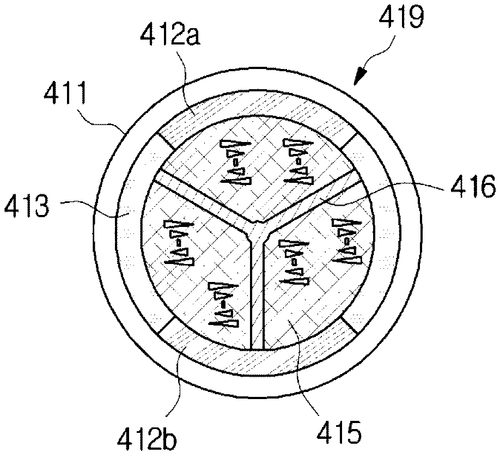
In a world where personal expression is key, Samsung Electronics Co., Ltd. has filed a patent for a smart garment that allows users to change designs with ease. Imagine a wardrobe where your outfit can transform with just a few clicks on your smartphone. This innovation could potentially revolutionize the fashion industry, giving consumers the power to refresh their style daily. Competitors in the smart clothing market, such as Google's Project Jacquard and CuteCi. rcuit, may need to step up their game if Samsung's patent comes to fruition. The ability to customize your clothing on the go could be a game-changer for the tech-savvy fashionistas out there. But the question remains: Will this smart garment become a staple in our closets, or is it just another ambitious idea that never sees the light of day? How would you utilize this technology in your daily life? Share your thoughts in the comments below.
Abstract
The disclosed embodiments provide a smart garment on which implemented designs can be changed in terms of color, image, text, etc. Also, a system is provided that comprises: a server for providing various designs to be implemented on a smart garment; and a user terminal that can change the design of the smart garment by receiving various designs from the server and transmitting same to the smart garment. The system according to the disclosed embodiments comprises: a server including a design database for a smart garment; a user terminal for downloading a design for the smart garment from the server; and the smart garment on which the design transmitted from the user terminal is implemented. The disclosed embodiments provide a smart garment on which implemented designs can be changed in terms of color, image, text, etc. Also, a system is provided that comprises: a server for providing various designs to be implemented on a smart garment; and a user terminal that can change the design of the smart garment by receiving various designs from the server and transmitting same to the smart garment. The system according to the disclosed embodiments comprises: a server including a design database for a smart garment; a user terminal for downloading a design for the smart garment from the server; and the smart garment on which the design transmitted from the user terminal is implemented.
US Patent 12035761
Samsung Electronics Co., Ltd.
"Samsung Electronics Co., Ltd. Patents Dual Fan Home Appliance Design for Optimal Airflow Control"
What is this invention?
Air conditioner and home appliance
There once was an appliance so grand,
With fans and a stator so planned,
Inlet, outlets, and more,
Air guided like never before,
Technology makes it all so well manned.
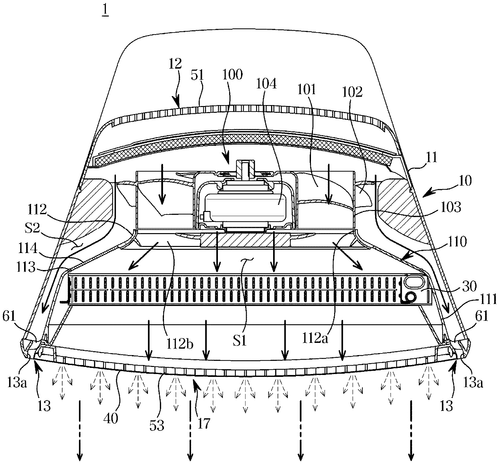
Samsung Electronics Co., Ltd. has patented a new home appliance that promises to revolutionize air circulation in our households. This invention features a unique design with two fans working simultaneously to ensure efficient airflow. The first fan directs air towards one outlet, while the second fan directs air towards a second outlet located nearby. Additionally, a stator guides the air from the first fan towards its designated outlet. Compared to existing home appliances on the market, this innovative design offers the potential for more customizable air circulation within a room. The dual fan system could lead to improved air distribution and ventilation, enhancing the overall comfort of any living space. With the increasing importance of indoor air quality and climate control, could this new home appliance from Samsung set a new standard for home ventilation systems? How do you think this technology could be integrated into our daily lives? Share your thoughts in the comments section below.
Abstract
A home appliance includes a housing including an inlet, a first outlet formed in the housing to discharge air introduced through the inlet, a second outlet disposed adjacent to the first outlet, a fan assembly including a first fan configured to discharge air toward the first outlet, and a second fan configured to discharge air toward the second outlet, and a stator provided to guide air, which is discharged from the first fan, to the first outlet. A home appliance includes a housing including an inlet, a first outlet formed in the housing to discharge air introduced through the inlet, a second outlet disposed adjacent to the first outlet, a fan assembly including a first fan configured to discharge air toward the first outlet, and a second fan configured to discharge air toward the second outlet, and a stator provided to guide air, which is discharged from the first fan, to the first outlet.
US Patent 12038182
Samsung Electronics Co., Ltd.
"Samsung Patents Innovative Refrigerator Design with Dual Storage Chambers and Advanced Airflow System"
What is this invention?
Refrigerator
In a fridge with a marvelous plan,
A damper controls airflow's span,
From main body to chambers two,
Cold air flows, fresh and true,
Efficient cooling for every clan.
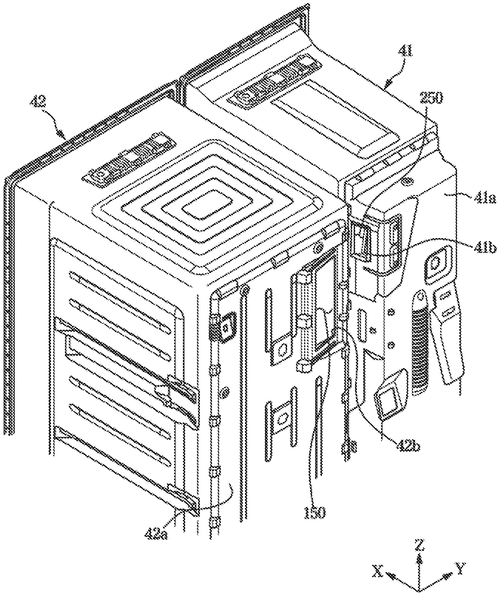
Samsung Electronics Co., Ltd. has filed a patent for a new refrigerator design that aims to revolutionize food storage. The appliance features a main body with two open-front storage chambers and a specialized cooling system. An evaporator generates cold air behind the first storage chamber, with separate ducts supplying cold air to each chamber. A unique connection duct allows for air to flow between the chambers when needed, controlled by a damper inside the first duct. This innovative layout presents a potential challenge to competitors in the refrigerator market, such as LG and Whirlpool. The design offers opportunities for improved organization and temperature control within the appliance, maximizing food preservation and freshness. While the patent showcases an exciting advancement in refrigerator technology, the question remains: Will consumers see the value in this intricate cooling system or prefer more traditional models? How important is customizable cooling and compartmentalization in your ideal refrigerator setup? Share your thoughts in the comments below.
Abstract
Provided is a refrigerator including a main body, a first storage chamber and a second storage chamber provided inside the main body with front sides thereof open, an evaporator, while being arranged inside the main body, configured to generate cold air and arranged behind the first storage chamber, a first duct configured to supply the cold air generated from the evaporator to the first storage chamber, a second duct configured to supply cold air to the second storage chamber, and a connection duct configured to connect the first duct and the second duct to cause the cold air inside the first duct to flow into the second duct, and a damper configured to selectively open and dose the connection duct, wherein the damper is provided inside the first duct, and the second duct has a front surface in a form of a flat surface. Provided is a refrigerator including a main body, a first storage chamber and a second storage chamber provided inside the main body with front sides thereof open, an evaporator, while being arranged inside the main body, configured to generate cold air and arranged behind the first storage chamber, a first duct configured to supply the cold air generated from the evaporator to the first storage chamber, a second duct configured to supply cold air to the second storage chamber, and a connection duct configured to connect the first duct and the second duct to cause the cold air inside the first duct to flow into the second duct, and a damper configured to selectively open and dose the connection duct, wherein the damper is provided inside the first duct, and the second duct has a front surface in a form of a flat surface.
US Patent 12038222
Samsung Electronics Co., Ltd.
"Samsung Patents Groundbreaking Method for Estimating Maximum Specific Capacity of Composite Electrodes"
What is this invention?
Apparatus and method for estimating specific capacity of electrode
In the realm of electrode tech, we find
A method quite clever and refined
By measuring lithiation and OCP
We predict the composite's capacity with glee
Innovations in energy we constantly find
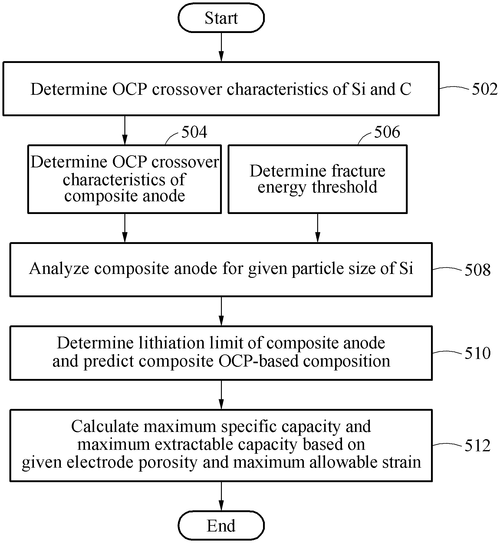
Samsung Electronics Co., Ltd. has recently patented a method to estimate the maximum specific capacity of a composite electrode made of silicon and natural graphite. This innovation involves analyzing the electrode's characteristics and composition to determine its lithium storage capacity. In a market dominated by competitors like Tesla and Panasonic, this patent could revolutionize the battery industry by potentially increasing energy storage capabilities in electronic devices and electric vehicles. Imagine a world where your smartphone's battery lasts twice as long or where electric cars can travel further distances on a single charge. Samsung's method could pave the way for more efficient and longer-lasting batteries, ultimately reducing our reliance on fossil fuels and advancing the green energy movement. As we eagerly anticipate the practical application of this technology, one can't help but wonder: How soon can we expect to see these high-capacity batteries in everyday products? Share your thoughts in the comments below.
Abstract
A method of estimating a maximum specific capacity of a composite electrode includes generating open circuit potential (OCP) crossover characteristics of the composite electrode comprising silicon and natural graphite, determining a composite electrode lithiation limit of the composite electrode based on a silicon lithiation limit of the silicon, predicting a composite electrode composition of the composite electrode based on the composite electrode lithiation limit, and estimating the maximum specific capacity of the composite electrode based on the composite electrode composition. A method of estimating a maximum specific capacity of a composite electrode includes generating open circuit potential (OCP) crossover characteristics of the composite electrode comprising silicon and natural graphite, determining a composite electrode lithiation limit of the composite electrode based on a silicon lithiation limit of the silicon, predicting a composite electrode composition of the composite electrode based on the composite electrode lithiation limit, and estimating the maximum specific capacity of the composite electrode based on the composite electrode composition.
US Patent 12038484
Samsung Electronics Co., Ltd.
"Samsung Patents Innovative Coating Technology for Curved Glass Surfaces in Electronic Devices"
What is this invention?
Curved glass comprising anti-reflection and anti-scratch coating layer and electronic device
In a device that's electronic and sleek,
There's a glass plate with layers unique.
With a coating that shines,
In different refractive lines,
This tech marvel leaves us all in mystique.
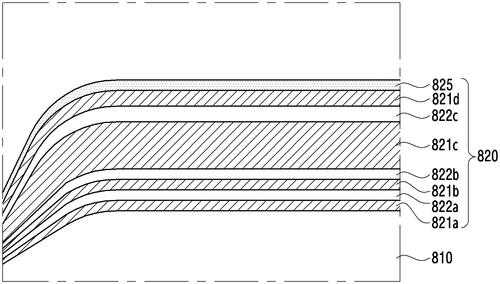
A recent patent from Samsung Electronics Co., Ltd. reveals an intriguing concept for an electronic device featuring a unique glass plate design with a specialized coating layer. The device incorporates a combination of flat and curved glass surfaces, along with a dual-layer coating featuring different refractive indices. While the patent does not specify the exact purpose of this innovative design, it could potentially offer enhanced visual aesthetics and improved display performance for future Samsung devices. Competitors in the electronic device market, such as Apple and Google, may need to take note of this inventive technology if it comes to fruition. The question that arises is whether this patented electronic device concept will eventually materialize into a tangible product that consumers can experience firsthand. How do you envision this technology being utilized in practical applications, and what impact could it have on the future of electronic devices? Share your thoughts in the comments below.
Abstract
Disclosed is an electronic device. An electronic device according to various embodiments includes: a housing; a first glass plate attached to the housing and forming a portion of an external surface of the electronic device, wherein the first glass plate includes a flat portion, a curved portion extending from an edge of the flat portion, a first surface facing outwardly from the electronic device, and a second surface facing inwardly towards the electronic device; and a coating layer formed on the first surface of the first glass plate, wherein the coating layer includes a first layer having a first refractive index and containing at least one first material, and includes a second layer disposed further from the first surface than the first layer, containing at least one second material, and having a second refractive index different from the first refractive index. Disclosed is an electronic device. An electronic device according to various embodiments includes: a housing; a first glass plate attached to the housing and forming a portion of an external surface of the electronic device, wherein the first glass plate includes a flat portion, a curved portion extending from an edge of the flat portion, a first surface facing outwardly from the electronic device, and a second surface facing inwardly towards the electronic device; and a coating layer formed on the first surface of the first glass plate, wherein the coating layer includes a first layer having a first refractive index and containing at least one first material, and includes a second layer disposed further from the first surface than the first layer, containing at least one second material, and having a second refractive index different from the first refractive index.
US Patent 12038558
QUALCOMM Incorporated
"Qualcomm Patent: Mobile Device Technology to Combat GNSS Spoofing Signals"
What is this invention?
GNSS spoofing detection and recovery
In the realm of tech, there's a plan,
To thwart spoofs with a clever scan,
By GNSS signals received,
The location's truth, it's believed,
Ensuring security as the method began.
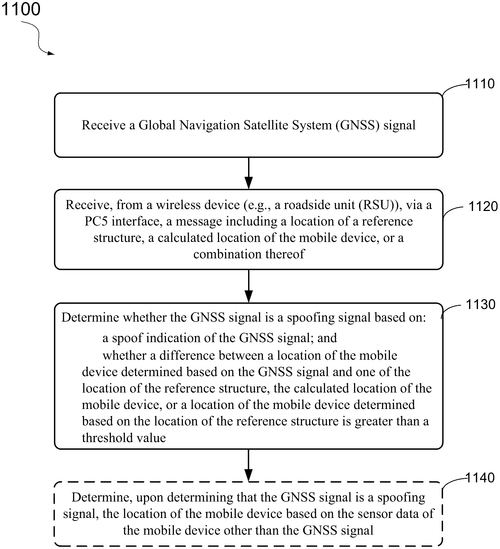
In a recent patent filed by QUALCOMM Incorporated, a method involving Global Navigation Satellite System (GNSS) signals and wireless devices has caught the eye of tech enthusiasts. The patent describes a system where a mobile device can determine if it is receiving a spoofed GNSS signal by comparing its location with that of a reference structure provided by a wireless device. This innovation could have profound implications for location-based services and navigation systems, potentially enhancing security and accuracy. Competitors in the market, such as Apple and Google, may need to take note of this development as it could give QUALCOMM a competitive edge in the future. Imagine a world where your smartphone can instantly detect if it's being fed false location data, ensuring that you always know exactly where you are. The possibilities for this technology are vast, from improving emergency response services to enhancing the efficiency of delivery systems. But will this patent translate into a tangible product that consumers can benefit from? Can we trust our devices to accurately discern between real and fake signals in real-world scenarios? Share your thoughts on the feasibility and potential impact of this invention in the comments below.
Abstract
A method includes, by a mobile device, receiving a Global Navigation Satellite System (GNSS) signal, and receiving, from a wireless device, via a PC5 interface, a message including a location of a reference structure. The method also includes determine whether the GNSS signal is a spoofing signal based on a difference between the location of the reference structure and a location of the mobile device determined based on the GNSS signal. A method includes, by a mobile device, receiving a Global Navigation Satellite System (GNSS) signal, and receiving, from a wireless device, via a PC5 interface, a message including a location of a reference structure. The method also includes determine whether the GNSS signal is a spoofing signal based on a difference between the location of the reference structure and a location of the mobile device determined based on the GNSS signal.
US Patent 12038515
QUALCOMM Incorporated
"QUALCOMM's Innovative Patent: Reducing Satellite Positioning System Ambiguity Search Space with Spatial Information"
What is this invention?
Integer ambiguity search space reduction
There's a method, so precise and neat,
To determine integers complete,
With satellite signals in the air,
And spatial data with great care,
A search space made finite and sweet.
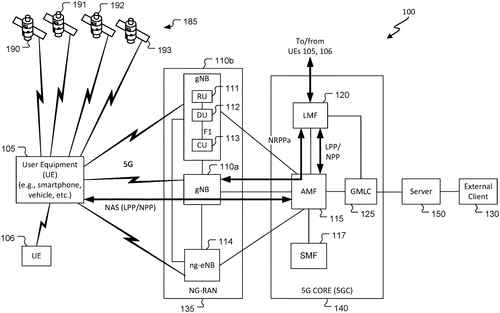
In a new patent from QUALCOMM Incorporated, a method for determining an integer ambiguity search space has been described. This technology involves obtaining code phase measurements of satellite signals and spatial information related to terrestrial signals. By utilizing this data, the system can determine a satellite positioning system carrier phase integer ambiguity search space and constrain its size based on the spatial information gathered. Competitors in the market, such as GPS device manufacturers and wireless network providers, will undoubtedly be watching closely to see if this patent translates into a tangible product. The potential applications for this technology are vast, ranging from improving the accuracy of GPS navigation systems to enhancing the efficiency of wireless communication networks. Will this patent lead to a groundbreaking new product that revolutionizes the way we utilize satellite positioning systems and wireless communication? Share your thoughts in the comments below!
Abstract
A method of determining an integer ambiguity search space includes: obtaining, at an apparatus, a code phase measurement of a satellite vehicle signal comprising a pseudorandom noise code and a carrier signal; obtaining, at the apparatus, spatial information corresponding to a wireless terrestrial signal transferred between the apparatus and a terrestrial base station; determining, at the apparatus, a satellite positioning system carrier phase integer ambiguity search space based on the code phase measurement; and constraining a size of the satellite positioning system carrier phase integer ambiguity search space based on the spatial information. A method of determining an integer ambiguity search space includes: obtaining, at an apparatus, a code phase measurement of a satellite vehicle signal comprising a pseudorandom noise code and a carrier signal; obtaining, at the apparatus, spatial information corresponding to a wireless terrestrial signal transferred between the apparatus and a terrestrial base station; determining, at the apparatus, a satellite positioning system carrier phase integer ambiguity search space based on the code phase measurement; and constraining a size of the satellite positioning system carrier phase integer ambiguity search space based on the spatial information.
US Patent 12038517
QUALCOMM Incorporated
"Revolutionizing Wireless Communications: Qualcomm's Patent for Radar Field of View Determination"
What is this invention?
Radar transmission parameter selection for multi-radar coexistence
In the world of wireless communication,
UEs determine radar's direction,
With parameters in sight,
They transmit messages just right,
Creating a seamless connection.
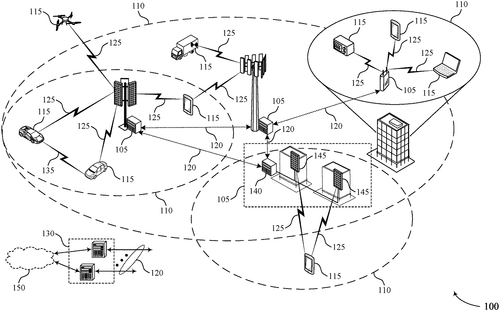
In a recent patent filing, QUALCOMM Incorporated has described innovative methods, systems, and devices for wireless communications, with a focus on radar technology. The patent details how a user equipment, such as a vehicle, can determine a radar field of view based on communication parameters, allowing for tailored radar transmission parameters to be set and radar messages to be transmitted accordingly. This advancement has the potential to revolutionize radar communications in various industries, particularly in the automotive sector. With the rise of autonomous vehicles, the ability to precisely control radar transmissions based on field of view could enhance safety and efficiency on the road. Competitors in the market, such as Tesla and Ford, may need to take note of this development to stay ahead in the race for cutting-edge wireless communication technologies. However, as with many patents, the ultimate question remains: will this technology be successfully implemented into a market-ready product? While the potential applications are promising, the practicality and scalability of this innovation will be crucial factors in determining its real-world impact. What are your thoughts on this new advancement in wireless communications technology? How do you envision this technology shaping the future of radar systems? Share your insights in the comments below.
Abstract
Methods, systems, and devices for wireless communications are described. A user equipment (UE), such as a vehicle UE may determine, based on one or more communication parameters of the UE, a radar field of view (FOV) for radar communications at the UE relative to a fixed frame of reference for the wireless communications system. The UE may determine a set of radar transmission parameters based on the radar FOV, where each radar transmission parameter of the set of radar transmission parameters is a function of the radar FOV. The UE may transmit a radar message using the set of radar transmission parameters according to the radar FOV relative to the fixed frame of reference. Methods, systems, and devices for wireless communications are described. A user equipment (UE), such as a vehicle UE may determine, based on one or more communication parameters of the UE, a radar field of view (FOV) for radar communications at the UE relative to a fixed frame of reference for the wireless communications system. The UE may determine a set of radar transmission parameters based on the radar FOV, where each radar transmission parameter of the set of radar transmission parameters is a function of the radar FOV. The UE may transmit a radar message using the set of radar transmission parameters according to the radar FOV relative to the fixed frame of reference.
US Patent 12038523
QUALCOMM Incorporated
"Qualcomm Patent Revolutionizes Safe Passenger Drop-offs for Autonomous Vehicles"
What is this invention?
Determining drop-off or pick-up locations for passengers of vehicles
In the realm of vehicle control, a tale,
Systems and methods to never fail,
A processor's task, without derail,
To find safe spots, a passenger's sail,
In the world of tech, we set the sail.
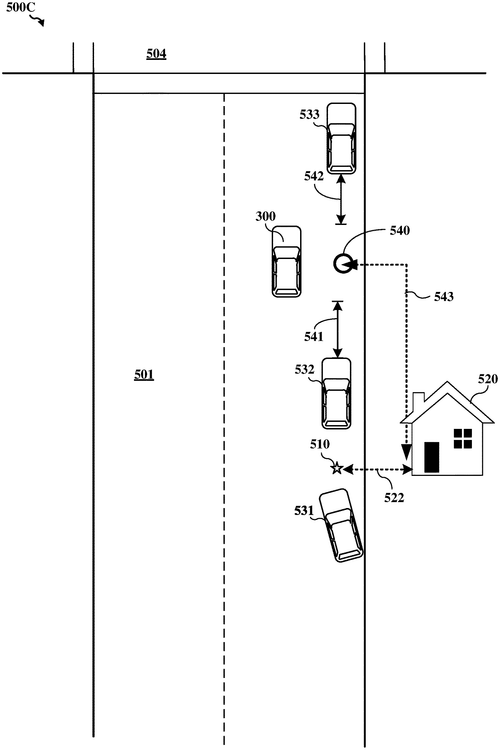
A new patent by Qualcomm Incorporated promises to revolutionize the way vehicles for passenger service operate. The technology involves a vehicle controller that can determine where a passenger will enter or exit the vehicle and adjust its drop-off or pick-up location based on any obstacles or hazardous conditions nearby. This innovation could potentially enhance safety and efficiency for services like ride-sharing and public transportation. Competitor companies in the autonomous vehicle industry, such as Tesla and Waymo, have been making strides in developing self-driving technology, but Qualcomm's patent introduces a unique twist by focusing on optimizing passenger experiences during pick-up and drop-off. Imagine a future where your ride service automatically adjusts its route to ensure a smooth and safe transition for passengers, avoiding obstacles and hazards along the way. This could not only streamline operations but also provide passengers with a more reliable and comfortable journey. As we look towards the future of transportation, the question arises: How important is personalized and adaptable service in the realm of autonomous vehicles? Share your thoughts in the comments below.
Abstract
This disclosure provides systems, methods, and apparatuses for controlling operations of a vehicle configured for passenger service. In some implementations, a vehicle controller includes one or more processors communicably coupled to a memory, the one or more processors configured to determine an expected entry or exit point for the passenger of the vehicle. The one or more processors may be configured to detect whether an obstacle or hazardous condition is present at or near a site. The one or more processors may be configured to determine, in response to detecting that the obstacle or hazardous condition is present at or near the site, a drop-off or pick-up location associated with the site based at least in part on a position of the expected entry or exit point for the passenger of the vehicle and the detected obstacle or hazardous condition. This disclosure provides systems, methods, and apparatuses for controlling operations of a vehicle configured for passenger service. In some implementations, a vehicle controller includes one or more processors communicably coupled to a memory, the one or more processors configured to determine an expected entry or exit point for the passenger of the vehicle. The one or more processors may be configured to detect whether an obstacle or hazardous condition is present at or near a site. The one or more processors may be configured to determine, in response to detecting that the obstacle or hazardous condition is present at or near the site, a drop-off or pick-up location associated with the site based at least in part on a position of the expected entry or exit point for the passenger of the vehicle and the detected obstacle or hazardous condition.
US Patent 12038749
QUALCOMM Incorporated
"QUALCOMM's Adaptive Refresh Commands Revolutionize Memory Systems for Enhanced Efficiency"
What is this invention?
Memory system with adaptive refresh
In the world of memory delight,
Refresh commands shine so bright.
Per bank and quad bank,
Octa bank, don't yank,
Efficiently keeping data tight.
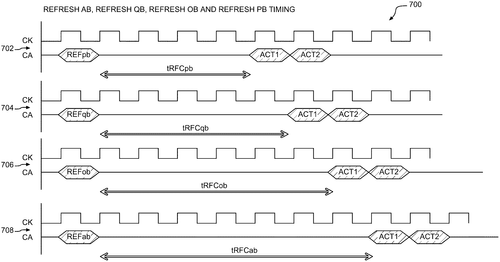
In the rapidly evolving world of memory systems, Qualcomm has unveiled a new patent for a memory system with adaptive refresh commands. This innovative technology allows for more efficient and targeted memory refreshing, potentially reducing power consumption and increasing overall performance. Competitors in the market, such as Samsung and Micron, currently offer memory solutions with traditional refresh mechanisms. Qualcomm's proposed system, with its ability to refresh specific banks of memory independently, could give them a competitive edge in the industry. Imagine the practical applications of this technology in mobile devices, where power efficiency is crucial. By refreshing only the necessary banks, smartphones and tablets could potentially see longer battery life and improved overall responsiveness. But the big question remains: Will Qualcomm be able to bring this patent to life and turn it into a market-ready product? Share your thoughts in the comments below.
Abstract
A memory system with adaptive refresh commands is disclosed. In one aspect, a memory system or device that has multiple banks within a channel may receive a per bank command that indicates a first bank to be refreshed and provides additional information about a second bank to be refreshed. In a further exemplary aspect, a quad bank refresh command may be sent that indicates a first bank to be refreshed and provides additional information about second through fourth banks to be refreshed. In a further exemplary aspect, an octa bank refresh command may be sent that indicates a first bank to be refreshed and provides additional information about second through eighth banks to be refreshed. The three new refresh commands allow adjacent or spaced banks to be refreshed. A memory system with adaptive refresh commands is disclosed. In one aspect, a memory system or device that has multiple banks within a channel may receive a per bank command that indicates a first bank to be refreshed and provides additional information about a second bank to be refreshed. In a further exemplary aspect, a quad bank refresh command may be sent that indicates a first bank to be refreshed and provides additional information about second through fourth banks to be refreshed. In a further exemplary aspect, an octa bank refresh command may be sent that indicates a first bank to be refreshed and provides additional information about second through eighth banks to be refreshed. The three new refresh commands allow adjacent or spaced banks to be refreshed.
US Patent 12038855
SAMSUNG ELECTRONICS CO., LTD.
"Samsung Electronics Patents Groundbreaking Chemical Formula for Next-Gen Technology"
What is this invention?
Monomer and polymer, compensation film, optical film, and display device
There once was a monomer so fine,
With Chemical Formula 1 as its sign,
It bonded with others to make,
Polymers that radiate,
In a chain, their beauty aligned.

Samsung Electronics has recently filed a patent for a new monomer, as evidenced by Chemical Formula 1. While the details may be a bit complex, the implications of this innovation are anything but. Competitors in the electronics industry will undoubtedly be keeping a close eye on Samsung's latest development to see if it will give them a leg up in the market. Imagine a world where this new monomer could revolutionize the displays on our smartphones, tablets, and even TVs. With the potential for enhanced clarity and durability, consumers could soon be experiencing a newfound level of satisfaction with their tech devices. But the big question remains: Will Samsung's patent actually materialize into a tangible product that we can all benefit from? What do you think about the possibilities of this new monomer? Share your thoughts in the comments below.
Abstract
A monomer represented by Chemical Formula 1:A monomer represented by Chemical Formula 1:
US Patent 12037304
SAMSUNG ELECTRONICS CO., LTD.
"Samsung's Innovative Washer-Dryer Communication System Reimagines Laundry Automation"
What is this invention?
Washing machine for controlling dryer, and dryer controlling method performed by washing machine
In a home where technology's prime,
A washer speaks to the dryer in rhyme.
With wireless communication they chatter,
In sync they make laundry matters much fatter.
Facing fronts aligned, they dance in time.
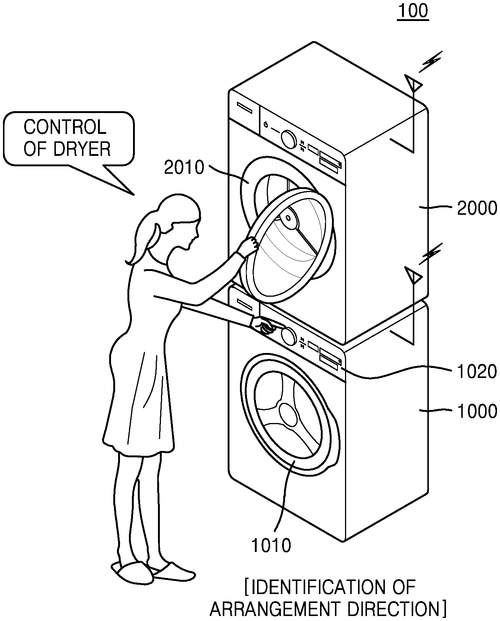
Samsung Electronics Co., Ltd. has filed a patent for an innovative washing machine that may revolutionize laundry day. This new invention features a communication interface that allows wireless communication with a dryer, a user interface for control and information output, and a processor that can determine the alignment of the washing machine and dryer. Imagine a world where your washer and dryer work in perfect harmony, seamlessly communicating to ensure your laundry comes out perfectly dry and ready to wear. While Samsung's patent hints at a future where our appliances may work together more effectively, it remains to be seen if this technology will make it to market. Competing with traditional washing machines and dryers already on the market, Samsung's invention raises the question of whether consumers are ready for a new era of interconnected appliances. Would you welcome a washing machine that communicates with your dryer for optimal results, or do you prefer the simplicity of standalone devices? Share your thoughts in the comments below.
Abstract
A washing machine includes a communication interface for wireless communication with a dryer; a user interface configured to receive a user's control input related to the dryer, and to output information related to the dryer; and at least one processor configured to determine whether a front surface of the dryer faces in a same direction as a front surface of the washing machine, and when it is determined that the front surface of the dryer faces in the same direction as the front surface of the washing machine, receive the user's control input related to the dryer through the user interface and transmit, to the dryer, a control command corresponding to the user's control input related to the dryer through the communication interface. A washing machine includes a communication interface for wireless communication with a dryer; a user interface configured to receive a user's control input related to the dryer, and to output information related to the dryer; and at least one processor configured to determine whether a front surface of the dryer faces in a same direction as a front surface of the washing machine, and when it is determined that the front surface of the dryer faces in the same direction as the front surface of the washing machine, receive the user's control input related to the dryer through the user interface and transmit, to the dryer, a control command corresponding to the user's control input related to the dryer through the communication interface.
US Patent 12037731
SAMSUNG ELECTRONICS CO., LTD.
"Samsung Patents Revolutionary Diamond-Like Carbon Coating for Compressor Moving Parts"
What is this invention?
Moving part, compressor, and manufacturing method thereof
In a compressor, a part that does move,
Made with materials smooth and groove,
Adhesive and diamond-like carbon it holds tight,
With microgrooves etched for efficiency's might,
A marvel of tech, this part, in its every groove.
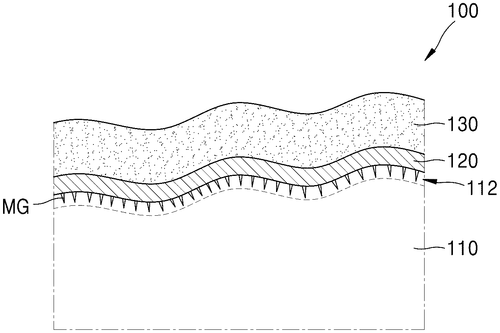
Samsung Electronics Co., Ltd. has recently patented a new innovation in compressor technology that incorporates a moving part with advanced materials and manufacturing techniques. The moving part includes a base material with a polished surface, an adhesive layer, and a coating layer made of diamond-like carbon. This design aims to improve the efficiency and durability of compressors used in various applications. While this new invention by Samsung showcases their commitment to pushing the boundaries of technology in compressor design, it will be interesting to see if they can successfully bring this product to market and compete with existing compressor manufacturers like LG and Mitsubishi Electric. Imagine the potential uses of this new compressor technology in home appliances, HVAC systems, and industrial machinery. How might this innovation impact energy efficiency and overall performance in these applications? Share your thoughts in the comments below.
Abstract
A moving part of a compressor, a compressor including the moving part, and a method of manufacturing the moving part, the moving part including a base material having a polished surface and including a steel material; an adhesive layer arranged on the polished surface; and a coating layer including diamond-like carbon. The adhesive layer may be arranged between the base material and the coating layer and bond the coating layer to the base material, and the base material may include an etching-processed area having a plurality of microgrooves (MG) extending in a downward direction into the base material from the polished surface. A moving part of a compressor, a compressor including the moving part, and a method of manufacturing the moving part, the moving part including a base material having a polished surface and including a steel material; an adhesive layer arranged on the polished surface; and a coating layer including diamond-like carbon. The adhesive layer may be arranged between the base material and the coating layer and bond the coating layer to the base material, and the base material may include an etching-processed area having a plurality of microgrooves (MG) extending in a downward direction into the base material from the polished surface.
US Patent 12038005
SAMSUNG ELECTRONICS CO., LTD.
"Samsung's Smart Refrigerator Patent Revolutionizes Cold Air Flow Control"
What is this invention?
Refrigerator
In a fridge, a cover assembly so neat,
With a knob to make cold air retreat.
The guide member slides,
Opening and closing with strides,
A high-tech cooling feat!
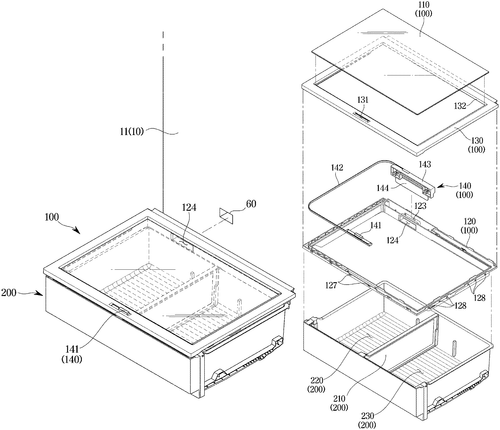
Samsung Electronics has recently filed a patent for a new refrigerator design that includes a storage compartment, a storage box, and a unique cover assembly. The cover assembly features a cover member, a frame, a knob, a connecting member, a guide member, and an opening and closing member. This design allows for efficient cooling of the storage box while providing easy access to its contents. Competing refrigerators on the market typically have standard shelves or bins for storage, but Samsung's inventive cover assembly could revolutionize how we interact with our fridges. Imagine being able to quickly adjust the airflow to keep different items at their optimal temperature or easily access commonly used items without having to fully open the refrigerator door. While this patent showcases a promising concept, the big question remains: Will Samsung bring this innovative refrigerator design to market, or will it remain just a concept on paper? How would you envision incorporating this technology into your daily life? Share your thoughts in the comments below.
Abstract
A refrigerator including a storage compartment, a storage box, and a cover assembly. The cover assembly including a cover member to cover an upper portion of the storage box, a frame provided along the cover member and configured to fix the cover member and comprising an opening provided to communicate with the discharge port to allow cold air to flow into the storage box, a knob configured to be movable and disposed on a side of the frame, a connecting member configured to slide inside the frame and connected to the knob, a guide member configured to be movable inside the frame based on a movement of the knob. The guide member comprising a guide hole, and an opening and closing member configured to open and close the opening by moving in a vertical direction along the guide hole. A refrigerator including a storage compartment, a storage box, and a cover assembly. The cover assembly including a cover member to cover an upper portion of the storage box, a frame provided along the cover member and configured to fix the cover member and comprising an opening provided to communicate with the discharge port to allow cold air to flow into the storage box, a knob configured to be movable and disposed on a side of the frame, a connecting member configured to slide inside the frame and connected to the knob, a guide member configured to be movable inside the frame based on a movement of the knob. The guide member comprising a guide hole, and an opening and closing member configured to open and close the opening by moving in a vertical direction along the guide hole.
US Patent 12038221
SAMSUNG ELECTRONICS CO., LTD.
"Samsung Patents Innovative Biomedical Analysis Apparatus with Impedance Sensor Technology"
What is this invention?
Apparatus and method for analyzing biological material component, and apparatus for measuring impedance
In a lab so cutting-edge and cool,
An apparatus analyzed to rule.
Impedance sensors with grace,
Measure bio materials' trace,
A processor brings knowledge from this dual.

Samsung Electronics Co., Ltd. has recently patented an innovative apparatus for analyzing biological material components with the use of an impedance sensor and a processor. This cutting-edge technology aims to revolutionize the way we analyze and understand biological samples. Competitor products in the market include similar impedance sensors used for various scientific and medical purposes, but Samsung's apparatus brings a unique twist with its ability to model impedance as an equivalent circuit for more precise analysis. Imagine the potential uses of this technology in medical diagnostics, environmental monitoring, or even food safety testing. The efficiency and accuracy of analyzing biological material components could lead to breakthroughs in research and advancements in various industries. As we look ahead to the future of this invention, one can't help but wonder: How could this apparatus impact the field of personalized medicine and precision healthcare? Share your thoughts in the comments below.
Abstract
An apparatus for analyzing a biological material component may include an impedance sensor comprising a first electrode having a first contact surface that contacts an analysis target, and a second electrode having a second contact surface that contacts the analysis target and that faces the first contact surface. The apparatus may include an impedance measurement assembly configured to measure impedance of the analysis target using the first electrode and the second electrode. The apparatus may include a processor configured to model the measured impedance as an equivalent circuit, and analyze a biological material component based on a modeling result. An apparatus for analyzing a biological material component may include an impedance sensor comprising a first electrode having a first contact surface that contacts an analysis target, and a second electrode having a second contact surface that contacts the analysis target and that faces the first contact surface. The apparatus may include an impedance measurement assembly configured to measure impedance of the analysis target using the first electrode and the second electrode. The apparatus may include a processor configured to model the measured impedance as an equivalent circuit, and analyze a biological material component based on a modeling result.
US Patent 12038399
Apple Inc.
"Apple Patent Revolutionizes Workout Monitoring with Innovative Interface Design"
What is this invention?
Workout monitor interface
In the realm of workout tech design,
Systems monitor each move and sign.
User interfaces shine,
With controls so fine,
Fitness tracking reaches its prime.
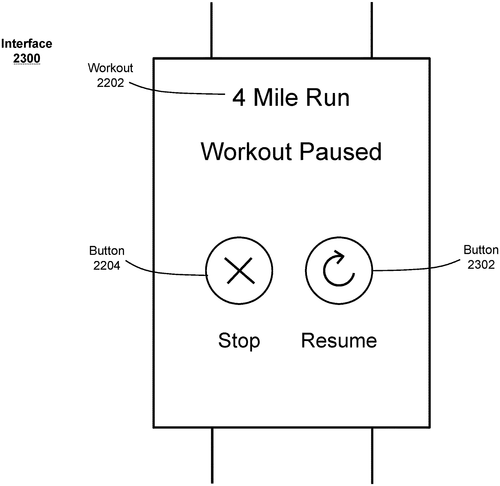
Apple Inc. has filed a patent for a system that aims to enhance the monitoring of workouts and improve the user interface for workout applications. The patent describes a process where user input during a workout session can trigger a control option to pause activity data collection while still continuing to receive data. This innovation could potentially revolutionize how users interact with workout apps, offering a more seamless and intuitive experience. Competing products in this space, such as Fitbit and Garmin, already offer advanced workout tracking features, but Apple's patent hints at a more user-centric approach that prioritizes ease of use and real-time control. Imagine a scenario where runners could effortlessly pause their workout data collection with a simple gesture, allowing them to catch their breath or take a quick break without interrupting the overall session tracking. Will this patented system from Apple be the game-changer in workout monitoring that consumers have been waiting for? How do you think this innovation could impact the future of fitness technology? Share your thoughts in the comments below.
Abstract
The present disclosure relates to systems and processes for monitoring a workout and for generating improved interfaces for the same. In one example, while receiving activity data for a workout session, a first user interface of a workout application is displayed. While displaying the first user interface of the workout application, user input of a first type is detected. In response to detecting the user input of the first type, a first control affordance to pause receiving the activity data for the workout session is displayed, and activity data for the workout session is continued to be received. The present disclosure relates to systems and processes for monitoring a workout and for generating improved interfaces for the same. In one example, while receiving activity data for a workout session, a first user interface of a workout application is displayed. While displaying the first user interface of the workout application, user input of a first type is detected. In response to detecting the user input of the first type, a first control affordance to pause receiving the activity data for the workout session is displayed, and activity data for the workout session is continued to be received.
US Patent 12036018
Apple Inc.
"Innovative Apple Patent Revolutionizes RSTD Reporting in Networks"
What is this invention?
RSTD measurement report mapping for NR positioning
In the realm of tech so advanced,
A method to make signals enhanced,
UE and circuit integrated,
RSTD values generated,
Connecting cells in a dance.
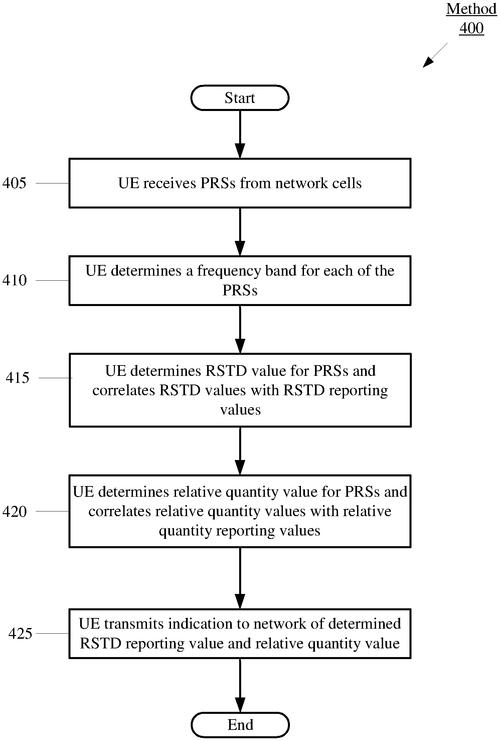
Apple Inc. recently filed a patent for a method, user equipment (UE), and integrated circuit aimed at improving the reporting of Reference Signal Time Difference (RSTD) values to a network. This technology allows a device to receive signals from different network cells, calculate time offsets, and transmit RSTD reporting values to the network. Competitors in the telecommunications industry such as Samsung and Huawei may need to take note of this potential innovation that could enhance network performance and accuracy in determining user locations. Imagine the possibilities of this technology in optimizing location-based services, improving network connectivity in crowded areas, and enhancing overall user experience. Could this patent signal a new era in network efficiency and reliability? Let us know your thoughts in the comments below.
Abstract
A method, UE and integrated circuit for reporting RSTD values to a network. A user equipment (UE) is configured to establish a connection to a network, the network comprising a first cell and a second cell. The UE receives a positioning reference signal from each of the first and second cells, determines a frequency band for each of the positioning reference signals, determines reference signal time difference (RSTD) values from measured time offsets between the positioning reference signals from the first and second cells, determines RSTD reporting values based on at least the RSTD values and the determined frequency bands and transmits an indication of the RSTD reporting values to the network. A method, UE and integrated circuit for reporting RSTD values to a network. A user equipment (UE) is configured to establish a connection to a network, the network comprising a first cell and a second cell. The UE receives a positioning reference signal from each of the first and second cells, determines a frequency band for each of the positioning reference signals, determines reference signal time difference (RSTD) values from measured time offsets between the positioning reference signals from the first and second cells, determines RSTD reporting values based on at least the RSTD values and the determined frequency bands and transmits an indication of the RSTD reporting values to the network.
US Patent 12038520
Apple Inc.
"Innovative Apple Patent Revolutionizes Display Technology with Stacked Data Lines"
What is this invention?
Displays with data lines that accommodate openings
In the border, data lines do stack,
To minimize width, it's a knack,
Metal layers three,
Form portions with glee,
In the active area, no lack.

Apple Inc. has filed a patent for a new technology aimed at reducing the width of the non-light-emitting border around the display's opening. By stacking data lines in the border region using three metal layers in different planes, the design aims to optimize space and improve the overall display quality. This innovation could potentially give Apple an edge over competitors in the display technology market, such as Samsung and LG, by offering a more immersive viewing experience with minimal border distractions. Imagine a future where your smartphone or tablet has a virtually edge-to-edge display, providing a seamless visual experience for watching videos, playing games, or browsing the web. This technology could also have applications in other devices, such as laptops or monitors, further enhancing the user experience across a range of products. As we look towards the next generation of displays, the question arises: Will this patent lead to a revolutionary new standard in display design, or will it remain another fascinating yet unrealized concept in the world of technology? Share your thoughts in the comments below.
Abstract
To minimize the width of a non-light-emitting border region around an opening in the active area, data lines may be stacked in the border region. Data line portions may be formed using three metal layers in three different planes within the border region. A metal layer that forms a positive power signal distribution path in the active area may serve as a data line portion in the border region. A metal layer may be added in the border region to serve as a data line portion in the border region. Data line signals may also be provided to pixels on both sides of an opening in the active area using supplemental data line paths. A supplemental data line path may be routed through the active area of the display to electrically connect data line segments on opposing sides of an opening within the display. To minimize the width of a non-light-emitting border region around an opening in the active area, data lines may be stacked in the border region. Data line portions may be formed using three metal layers in three different planes within the border region. A metal layer that forms a positive power signal distribution path in the active area may serve as a data line portion in the border region. A metal layer may be added in the border region to serve as a data line portion in the border region. Data line signals may also be provided to pixels on both sides of an opening in the active area using supplemental data line paths. A supplemental data line path may be routed through the active area of the display to electrically connect data line segments on opposing sides of an opening within the display.
US Patent 12038659
Apple Inc.
"Apple Patent Revolutionizes Media Library Navigation with Semantic Mapping Technology"
What is this invention?
Behavioral curation of media assets
In the tech world, a device may create
A semantic map to help navigate
Identifying features found
In media assets all around
To present top tier content, it's a great showcase
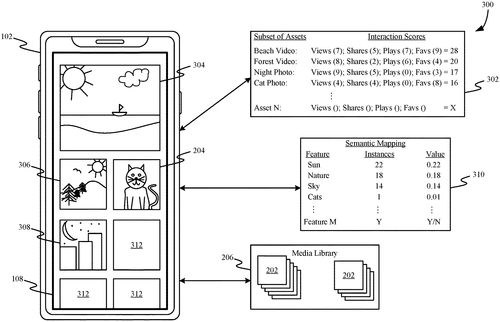
Apple Inc. has recently filed a patent that explores a new method for organizing and presenting media assets in a user-friendly way. The patent describes a system where a computing device analyzes features of media assets to generate semantic scores, ultimately highlighting the highest-rated assets in a user interface. This innovation could potentially revolutionize the way users interact with their media libraries, offering a more personalized and efficient experience. Competitors in the tech industry, such as Google and Amazon, have also been exploring similar approaches to enhance user interaction with media content. However, Apple's patent showcases a unique twist by focusing on semantic analysis to prioritize assets based on user preferences. Imagine a scenario where your music library automatically surfaces your favorite songs based on detailed semantic analysis, or where your photo gallery highlights the most aesthetically pleasing images for easy access. This patent could lead to more intuitive and tailored experiences across various media platforms. As we look towards the future of media organization and consumption, the question arises: How important is personalization in your digital experience? Share your thoughts in the comments below.
Abstract
In some implementations, a computing device may create a semantic mapping that includes identified features that appear in a particular percentage of assets in a subset of assets of a media library. Also, the computing device may analyze assets of the media library using the semantic mapping to generate semantic scores, which may be used to determine a first tier of assets from the media library that rate highest for semantic score out of all assets. The computing device may present at least one of the first tier assets prominently in a user interface when viewing assets of the media library. In some implementations, a computing device may create a semantic mapping that includes identified features that appear in a particular percentage of assets in a subset of assets of a media library. Also, the computing device may analyze assets of the media library using the semantic mapping to generate semantic scores, which may be used to determine a first tier of assets from the media library that rate highest for semantic score out of all assets. The computing device may present at least one of the first tier assets prominently in a user interface when viewing assets of the media library.
US Patent 12038964
Apple Inc.
"Apple's New Patent Allows Remote Control of Children's Devices for Parental Restrictions"
What is this invention?
Configuring context-based restrictions for a computing device
In tech realms where children dwell,
Parents can cast a restrictive spell.
With devices controlled,
Policies unfold,
Ensuring things run smoothly and well.
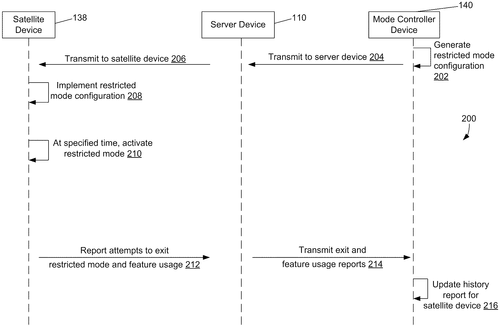
Apple Inc. has filed a patent for a new technology that allows a parent to remotely restrict the use of their children's devices while they are in school or engaged in other activities. This innovative solution would enable parents to control and manage the usage of multiple devices from their own device without the need for physical access to the children's devices. Competitors in the market, such as Google and Amazon, offer similar parental control features, but Apple's proposal seems to streamline the process by offering a more seamless and remote management solution. Potential uses for this technology could extend beyond parental control to corporate settings, where employers could manage and monitor the devices of their employees to ensure productivity and security. Could this new technology revolutionize the way families and businesses manage device usage in the future? Share your thoughts in the comments below.
Abstract
In some implementations, a computing device can restrict the use of another computing device in certain contexts. For example, a parent may wish to use the parent's computing device to restrict her children's use of the children's computing devices while the children are in school while the children should be participating in some other activity. For example, the parent's controller device may be enabled to remotely configure and control the usage of the satellite device(s) without needing to physically access the satellite device. The parent may implement limitations, permissions, or different policies that may govern, for example, the ability of the satellite device to communicate with other devices, execute various application functionalities, run any particular software, and manage its own settings. In some implementations, a computing device can restrict the use of another computing device in certain contexts. For example, a parent may wish to use the parent's computing device to restrict her children's use of the children's computing devices while the children are in school while the children should be participating in some other activity. For example, the parent's controller device may be enabled to remotely configure and control the usage of the satellite device(s) without needing to physically access the satellite device. The parent may implement limitations, permissions, or different policies that may govern, for example, the ability of the satellite device to communicate with other devices, execute various application functionalities, run any particular software, and manage its own settings.
US Patent 12039086
HUAWEI TECHNOLOGIES CO., LTD.
"Breaking Innovation: Huawei Technologies Revolutionizes Memory Card Testing with New Patented System"
What is this invention?
Test system for memory card
In the realm of memory card test,
A system of circuits does its best.
Contact groups and slots in rows align,
Second board with test circuit doth shine.
Ensuring quality, passing the crest.
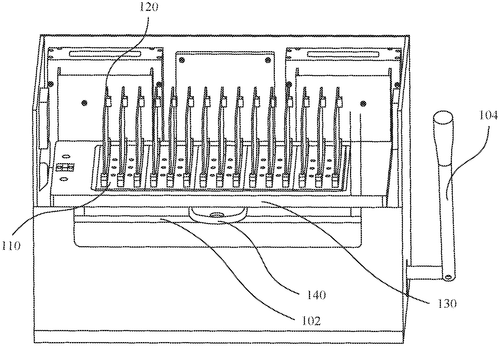
Innovative patent by HUAWEI TECHNOLOGIES CO., LTD. recently caught our eye with its new test system for memory cards. This system features a clever design with two circuit boards - one with contact groups and the other with a test circuit, allowing for efficient testing of memory cards. While competing products in the market offer similar functionalities, this patent showcases a unique approach that may streamline the testing process for manufacturers. Imagine the potential uses in quality control processes for memory card production, ensuring that each card meets the required standards before reaching consumers. As we consider the practicality of this invention, one must wonder: will this patented test system revolutionize the way memory cards are tested in the industry? Share your thoughts below.
Abstract
A test system for a memory card includes a first circuit board. One side of the first circuit board is provided with a plurality of contact groups spaced apart from each other along a row direction. Another side of the first circuit board is provided with slots disposed along the row direction. The test system further includes a second circuit board. The second circuit board is provided with a test circuit, and is inserted into the slot along a direction perpendicular to the first circuit board. The second circuit board provides a test signal to the contact groups. A test system for a memory card includes a first circuit board. One side of the first circuit board is provided with a plurality of contact groups spaced apart from each other along a row direction. Another side of the first circuit board is provided with slots disposed along the row direction. The test system further includes a second circuit board. The second circuit board is provided with a test circuit, and is inserted into the slot along a direction perpendicular to the first circuit board. The second circuit board provides a test signal to the contact groups.
US Patent 12038470
HUAWEI TECHNOLOGIES CO., LTD.
"Huawei's Innovative Ferrule Design Revolutionizes Optical Fiber Communication Technology"
What is this invention?
Ferrule, optical connector, optical communication element, communications device, and preparation method
In a ferrule, technology shines bright,
With fiber and film, all in sight,
Reflective and clear,
Communication near,
Light's journey made perfect, just right.

In the world of optical technology, Huawei Technologies Co., Ltd. has unveiled a fascinating new patent that could potentially revolutionize the way optical fibers are utilized. The patent describes a ferrule that incorporates an optical fiber and a dielectric reflective film, which allows for the reflection of light received from a matching ferrule. This innovation opens up a world of possibilities for applications in telecommunications, data transmission, and beyond. Imagine lightning-fast data transfers with minimal signal loss, or improved connectivity in futuristic devices that rely on optical communication. While the concept is certainly intriguing, the question remains: will Huawei be able to bring this patent to life and compete with established products in the market? How will this technology be implemented on a larger scale and integrated into existing systems? Share your thoughts in the comments below.
Abstract
A ferrule includes a ferrule matrix, an optical fiber, and a dielectric reflective film. The optical fiber is disposed in an accommodating through hole of the ferrule matrix, and the dielectric reflective film covers an optical transmission surface of the optical fiber and a surface that is of the ferrule matrix and that faces a matching ferrule. The dielectric reflective film has a through hole, such that the dielectric reflective film does not shield a main optical path area of the optical transmission surface of the optical fiber. A reflective band of the dielectric reflective film includes at least a part of a communication band of the optical fiber. In this way, when light from the matching ferrule is transmitted to the ferrule matrix and the optical fiber, the dielectric reflective film reflects the light. A ferrule includes a ferrule matrix, an optical fiber, and a dielectric reflective film. The optical fiber is disposed in an accommodating through hole of the ferrule matrix, and the dielectric reflective film covers an optical transmission surface of the optical fiber and a surface that is of the ferrule matrix and that faces a matching ferrule. The dielectric reflective film has a through hole, such that the dielectric reflective film does not shield a main optical path area of the optical transmission surface of the optical fiber. A reflective band of the dielectric reflective film includes at least a part of a communication band of the optical fiber. In this way, when light from the matching ferrule is transmitted to the ferrule matrix and the optical fiber, the dielectric reflective film reflects the light.
US Patent 12038612
HUAWEI TECHNOLOGIES CO., LTD.
"New Patent by Huawei: Remote Direct Memory Access for Improved Storage System Access"
What is this invention?
Method and apparatus for accessing storage system
In accessing storage, a client did send,
To a node where the device does extend,
Through RDMA command, so swift and grand,
Start and logical addresses in hand,
Efficiently accessing as they intend.
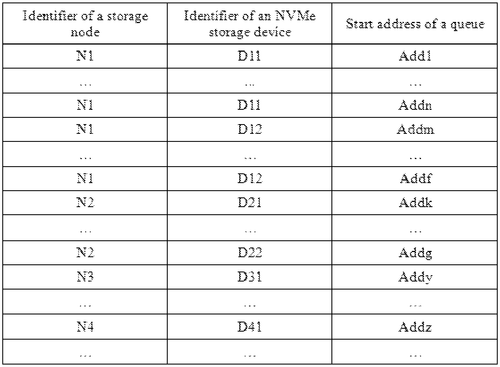
Huawei Technologies Co., Ltd. has recently filed a patent for a new method of accessing a storage system. This innovation involves a client sending remote direct memory access commands to a storage node where the NVMe storage device is located, based on specific start and logical addresses obtained from the access request. Competitors in the storage system industry, such as Samsung and Western Digital, may need to take note of this potential breakthrough in storage technology. If successfully developed, this invention could revolutionize the way data is accessed and stored, leading to faster and more efficient storage solutions. Imagine the possibilities of implementing this technology in cloud storage systems, allowing for quicker and more seamless access to data across various devices. However, the practicality and feasibility of bringing this invention to life on a large scale remain to be seen. What are your thoughts on this new approach to accessing storage systems? Do you believe it has the potential to reshape the storage industry as we know it? Share your insights in the comments below.
Abstract
In a solution for accessing a storage system, a client sends, based on an obtained start address that is of a queue of an NVMe storage device and to which an access request points and an obtained logical address that is of the NVMe storage device and to which the access request points, a remote direct memory access command to a storage node in which the NVMe storage device is located. In a solution for accessing a storage system, a client sends, based on an obtained start address that is of a queue of an NVMe storage device and to which an access request points and an obtained logical address that is of the NVMe storage device and to which the access request points, a remote direct memory access command to a storage node in which the NVMe storage device is located.
US Patent 12038851
HUAWEI TECHNOLOGIES CO., LTD.
"Revolutionizing Database Management: Huawei's Innovative Method for Electing Leader Thread in DBMS"
What is this invention?
Method and system for non-blocking database logging batching
In a DBMS system so grand,
Leader thread takes the command,
From concurrent threads stored,
In data nodes, it's explored,
Reducing contention, making a stand.
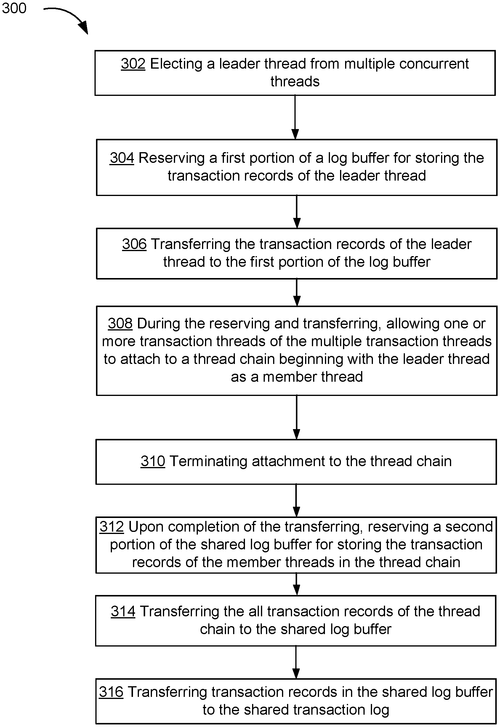
In a world where data management is king, Huawei Technologies Co., Ltd. is looking to revolutionize the game with their latest patent. The method and system described in the patent aim to streamline database management by electing a leader thread from concurrent transaction threads, allowing for smoother operation and reduced contention for shared buffer. Competitors in the field, such as Oracle and Microsoft, may need to take note of this innovative approach to database management as it could potentially change the game. Imagine a future where businesses can manage their data more efficiently, leading to faster processing times and improved overall performance. This could have a significant impact on industries ranging from finance to healthcare, where data integrity and speed are crucial. But the question remains: Will Huawei be able to turn this patent into a practical and marketable product? Share your thoughts in the comments below.
Abstract
Methods and system for a database management system (DBMS) in which a leader thread is elected from concurrent transaction threads stored in one or more data nodes. While the leader thread copies its own thread transaction log onto a reserved portion of the shared log buffer, the leader thread permits other transaction threads to attach to a thread chain starting with the leader thread. Once the leader has completed copying its thread transaction log onto the shared log buffer, it then reserves a portion of the shared log buffer, and copies the member thread transaction logs onto the shared log buffer to reduce the contention for shared buffer may be reduced. Methods and system for a database management system (DBMS) in which a leader thread is elected from concurrent transaction threads stored in one or more data nodes. While the leader thread copies its own thread transaction log onto a reserved portion of the shared log buffer, the leader thread permits other transaction threads to attach to a thread chain starting with the leader thread. Once the leader has completed copying its thread transaction log onto the shared log buffer, it then reserves a portion of the shared log buffer, and copies the member thread transaction logs onto the shared log buffer to reduce the contention for shared buffer may be reduced.
US Patent 12038901
HUAWEI TECHNOLOGIES CO., LTD.
"Huawei Patents Groundbreaking AI Recommendation Model Training Method"
What is this invention?
Recommendation model training method, recommendation method, apparatus, and computer-readable medium
In AI's vast and bright domain,
Where recommendation models reign,
Training methods pave the way,
To brighten accuracy's ray,
Alleviating data bias and its bane.
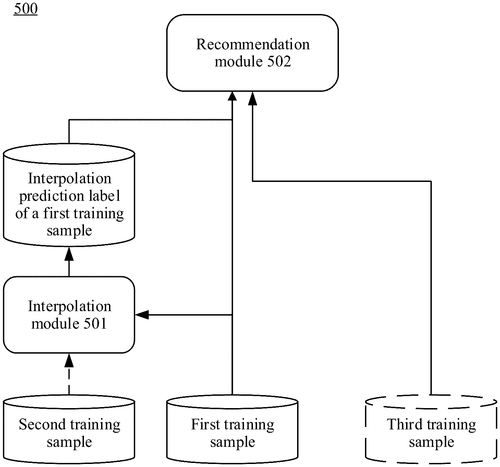
In a world where AI-driven recommendations are becoming increasingly ubiquitous, Huawei Technologies Co., Ltd. has filed a patent for a recommendation model training method that aims to address the issue of training data bias. The method outlined in the patent involves processing user attribute information and object details to enhance the accuracy of recommendation models. Competitors in the AI field, such as Amazon with its personalized product recommendations and Netflix with its tailored content suggestions, have set high standards for algorithm-driven suggestions. Huawei's proposed training method could potentially lead to more precise and relevant recommendations for users across various platforms and services. Imagine a future where your daily choices are guided by AI algorithms that truly understand your preferences and needs, thanks to advanced recommendation models like the one described in this patent. Could this method revolutionize the way we discover new products, services, and content online? How important is transparency and accountability in the development of AI-driven technologies? Let us know your thoughts in the comments below.
Abstract
This application provides a recommendation model training method in the artificial intelligence (AI) field. The training method includes: obtaining a first training sample; processing attribute information of a first user and information about a first recommended object based on an interpolation model, to obtain an interpolation prediction label of the first training sample; and performing training by using the attribute information of the first user and the information about the first recommended object as an input to a recommendation model and using the interpolation prediction label of the first training sample as a target output value of the recommendation model, to obtain a trained recommendation model. According to the technical solutions of this application, impact of training data bias on recommendation model training can be alleviated, and recommendation model accuracy can be improved. This application provides a recommendation model training method in the artificial intelligence (AI) field. The training method includes: obtaining a first training sample; processing attribute information of a first user and information about a first recommended object based on an interpolation model, to obtain an interpolation prediction label of the first training sample; and performing training by using the attribute information of the first user and the information about the first recommended object as an input to a recommendation model and using the interpolation prediction label of the first training sample as a target output value of the recommendation model, to obtain a trained recommendation model. According to the technical solutions of this application, impact of training data bias on recommendation model training can be alleviated, and recommendation model accuracy can be improved.
US Patent 12038986
****
"Revolutionizing Lawn Care: Mobile Multi-Tool System with Ambidextrous Blowing and Spray Capabilities"
What is this invention?
Multi-task blower platform, device and system
There once was a multi-tool so fine,
For lawn care, it was quite the find.
With spraying, blowing, and more,
For maintenance, a great score,
A tech marvel in the garden, in line.
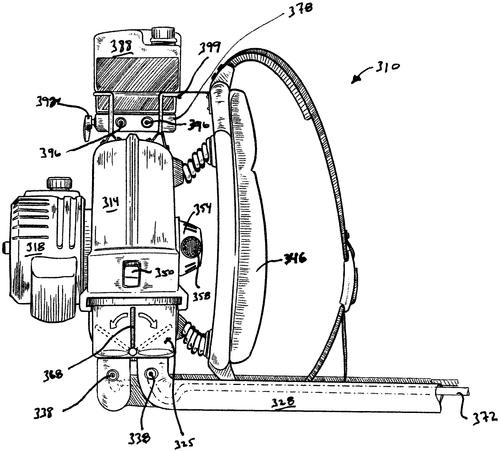
Are you tired of lugging around multiple tools for your lawn maintenance needs? Well, a recent patent describing a multi-tool system might just have the solution for you. This innovative system aims to revolutionize lawn care by offering users ambidextrous blowing capabilities, the ability to spray fertilizers, herbicides, and pesticides, all while using spline drive tools simultaneously. With the convenience of combining multiple functions into one device, this mobile multi-tool system could potentially streamline the lawn care process and make it more efficient for users. Imagine being able to blow leaves, fertilize your lawn, and trim hedges all with one tool. While this patent sounds promising, one can't help but wonder if this all-in-one solution will see the light of day in the market. Competitors in the lawn care industry already offer specialized tools for each task, so the question remains: will consumers embrace this multi-functional approach or stick to traditional, single-purpose tools? What do you think? Would you invest in a multi-tool system for your lawn care needs, or do you prefer the tried and true individual tools? Let us know in the comments below!
Abstract
According to one example, a multi-tool system for use in lawn maintenance and care. In use, one example provides the user with ambidextrous blowing capabilities, the ability to spray fertilizers, herbicides and pesticides, and use one or more spline drive tools at the same time as the blower and spray systems. A mobile multi-tool system for use in lawn maintenance and care. According to one example, a multi-tool system for use in lawn maintenance and care. In use, one example provides the user with ambidextrous blowing capabilities, the ability to spray fertilizers, herbicides and pesticides, and use one or more spline drive tools at the same time as the blower and spray systems. A mobile multi-tool system for use in lawn maintenance and care.
US Patent 12035661
****
"Revolutionary Patent Harnesses Moonlight for Plant Growth Optimization"
What is this invention?
Red light converter for conversion of inactive phytochrome
In the garden where moonlight gleams,
A far-red light device beams,
Activating Pfr with ease,
A technology to appease,
Short-day plants, fulfilling their dreams.

A new patent application has been making waves in the world of plant technology with its innovative approach to optimizing the growth of short-day plants. The activation of a far-red light device, which includes a special frequency of moonlight light, is said to promote the conversion of inactive Pfr to active Pr in these plants just before they enter a dark period. This breakthrough could potentially revolutionize the way short-day plants are cultivated, offering a more efficient and effective method of promoting growth and development. While there are already products on the market that utilize red and blue light spectrums to aid in plant growth, the incorporation of moonlight light in this new invention sets it apart from its competitors. The unique approach of utilizing far-red light frequencies in conjunction with moonlight light could prove to be a game-changer for farmers and gardeners looking to improve the health and yield of their short-day plants. Imagine the possibilities of incorporating this technology into greenhouse or indoor farming setups, where precise light control is essential for successful plant growth. Could this patent be the key to unlocking higher yields and better overall plant health? How might this new invention impact the future of agriculture and food production? Let us know your thoughts in the comments below!
Abstract
Activation of a far-red light device with a far-red light frequency that includes moonlight light that promotes the conversion of inactive Pfr to active Pr in short-day plants prior to a dark period. Activation of a far-red light device with a far-red light frequency that includes moonlight light that promotes the conversion of inactive Pfr to active Pr in short-day plants prior to a dark period.
US Patent 12035664
****
"Revolutionary Wheat Variety 6PVLC66B Sparks Innovative Plant Breeding Techniques"
What is this invention?
Wheat variety 6PVLC66B
In the realm of wheat, so gleaming,
Variety 6PVLC66B is beaming,
Crossed with another plant so sly,
New hybrids emerge, reaching for the sky,
Technology in agriculture, always dreaming.

A new wheat variety, 6PVLC66B, has been patented, along with methods for producing plants and seeds from this wheat variety. This patent also covers the creation of new wheat varieties through breeding and genetic modification techniques. In a market dominated by wheat producers like Monsanto and Syngenta, this new variety could potentially shake up the agricultural industry. With its potential for high yield and disease resistance, farmers may find 6PVLC66B to be a valuable addition to their fields. Imagine a future where this new wheat variety becomes a staple in bread production, providing a more sustainable and efficient source of wheat. However, questions remain about the scalability and viability of mass-producing this new variety. Will wheat variety 6PVLC66B finally revolutionize the wheat industry, or will it remain just another patent sitting on the shelf? Let us know your thoughts in the comments below.
Abstract
A wheat variety designated 6PVLC66B, the plants and seeds of wheat variety 6PVLC66B, methods for producing a wheat plant produced by crossing the variety 6PVLC66B with another wheat plant, and hybrid wheat seeds and plants produced by crossing the variety 6PVLC66B with another wheat line or plant, and the creation of variants by backcrossing, mutagenesis or transformation of variety 6PVLC66B are disclosed. Methods for producing other wheat varieties or breeding lines derived from wheat variety 6PVLC66B and to wheat varieties or breeding lines produced by those methods are also provided. A wheat variety designated 6PVLC66B, the plants and seeds of wheat variety 6PVLC66B, methods for producing a wheat plant produced by crossing the variety 6PVLC66B with another wheat plant, and hybrid wheat seeds and plants produced by crossing the variety 6PVLC66B with another wheat line or plant, and the creation of variants by backcrossing, mutagenesis or transformation of variety 6PVLC66B are disclosed. Methods for producing other wheat varieties or breeding lines derived from wheat variety 6PVLC66B and to wheat varieties or breeding lines produced by those methods are also provided.
US Patent 12035669
****
"Revolutionizing Agriculture: Patent Unveils Groundbreaking Maize Variety X15R412 and Innovative Plant Breeding Methods"
What is this invention?
Maize hybrid X15R412
In labs where new tech is the star,
X15R412 makes its mark from afar.
Enhanced through backcrossing finesse,
This maize variety, no less,
Shows how innovation can raise the bar.

In a recent patent filing, a new maize variety called X15R412 has been introduced, promising potential advancements in agricultural productivity. The method involves crossing specific inbred maize varieties to create this novel variety. The patent also outlines procedures for incorporating various traits into X15R412 through breeding or genetic manipulation. While the scientific implications of this patent are intriguing, it remains to be seen if this maize variety will translate into a commercially viable product. In a market already saturated with various maize cultivars, X15R412 will need to offer distinct advantages to stand out from competitors' products. Potential applications for this new maize variety could include increased yield, enhanced disease resistance, or improved nutritional content. However, the success of X15R412 will depend on factors such as regulatory approval, market demand, and practical feasibility for farmers. As we look to the future of agriculture, innovations like X15R412 hold promise for addressing global food security challenges. How do you think this new maize variety could impact the agricultural industry? Share your thoughts in the comments below.
Abstract
A novel maize variety designated X15R412 and seed, plants and plant parts thereof are produced by crossing inbred maize varieties. Methods for producing a maize plant by crossing hybrid maize variety X15R412 with another maize plant are disclosed. Methods for producing a maize plant containing in its genetic material one or more traits introgressed into X15R412 through backcrossing or genetic transformation, and to the maize seed, plant and plant part produced thereby are described. Maize variety X15R412, the seed, the plant produced from the seed, and variants, mutants, and minor modifications of maize variety X15R412 are provided. Methods for producing maize varieties derived from maize variety X15R412 and methods of using maize variety X15R412 are disclosed. A novel maize variety designated X15R412 and seed, plants and plant parts thereof are produced by crossing inbred maize varieties. Methods for producing a maize plant by crossing hybrid maize variety X15R412 with another maize plant are disclosed. Methods for producing a maize plant containing in its genetic material one or more traits introgressed into X15R412 through backcrossing or genetic transformation, and to the maize seed, plant and plant part produced thereby are described. Maize variety X15R412, the seed, the plant produced from the seed, and variants, mutants, and minor modifications of maize variety X15R412 are provided. Methods for producing maize varieties derived from maize variety X15R412 and methods of using maize variety X15R412 are disclosed.
US Patent 12035671
****
"Innovative Maize Patent: Introducing Variety 1PFWA03 for Enhanced Plant Traits"
What is this invention?
Maize inbred 1PFWA03
In the world of maize tech so bright,
1PFWA03 shines with genetic might.
Crossing plants to create new breed,
Transforming traits with agile speed.
Hybrid maize, a marvel in our sight.

In a recent patent application, a new maize variety designated 1PFWA03 has been introduced, along with the associated seeds, plants, and plant parts. The patent outlines methods for producing maize plants by crossing 1PFWA03 with other maize plants, as well as incorporating desired genetic traits through backcross conversion or transformation. The result is the production of hybrid maize seeds, plants, or plant parts through further crosses with different maize varieties. This innovation adds a new player to the world of maize cultivation, which is currently dominated by several key competitor products known for their high yield and pest resistance. With the potential to introduce novel genetic traits into maize plants, 1PFWA03 could offer farmers new options for improving crop resilience and productivity. Imagine the possibilities if this new maize variety proves successful in real-world farming conditions. How might it impact the agricultural industry and food production? Share your thoughts in the comments below.
Abstract
A novel maize variety designated 1PFWA03 and seed, plants and plant parts thereof are provided. Methods for producing a maize plant comprise crossing maize variety 1PFWA03 with another maize plant are provided. Methods for producing a maize plant containing in its genetic material one or more traits introgressed into 1PFWA03 through backcross conversion and/or transformation, and to the maize seed, plant and plant part produced thereby are provided. Hybrid maize seed, plants or plant parts are produced by crossing the variety 1PFWA03 or a locus conversion of 1PFWA03 with another maize variety. A novel maize variety designated 1PFWA03 and seed, plants and plant parts thereof are provided. Methods for producing a maize plant comprise crossing maize variety 1PFWA03 with another maize plant are provided. Methods for producing a maize plant containing in its genetic material one or more traits introgressed into 1PFWA03 through backcross conversion and/or transformation, and to the maize seed, plant and plant part produced thereby are provided. Hybrid maize seed, plants or plant parts are produced by crossing the variety 1PFWA03 or a locus conversion of 1PFWA03 with another maize variety.
US Patent 12035672